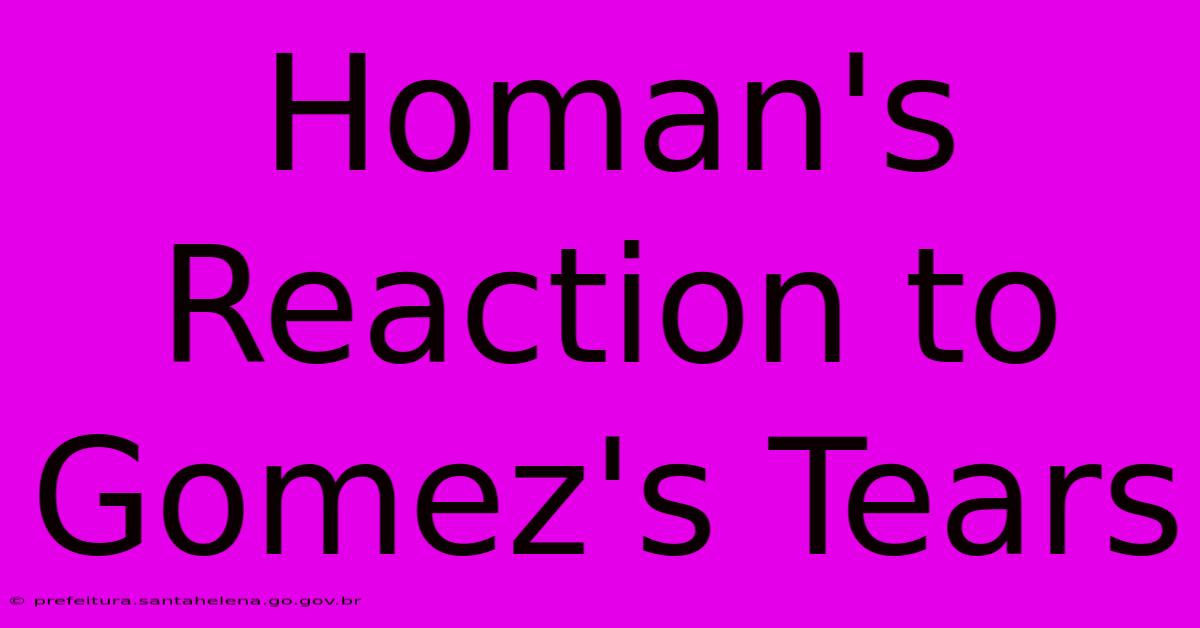Homan's Reaction To Gomez's Tears

Discover more detailed and exciting information on our website. Click the link below to start your adventure: Visit Best Website. Don't miss out!
Table of Contents
Homan's Reaction to Gomez's Tears: A Deep Dive into Complex Emotions
The fleeting moment captured – Gomez's tears, Homan's reaction – can spark a thousand interpretations. Understanding the nuances of human emotion, particularly in the context of a seemingly simple interaction, requires a careful examination of various factors. This article explores the potential interpretations of Homan's reaction to Gomez's tears, considering the context, the individuals involved, and the vast spectrum of human responses to emotional displays. We'll delve into the psychology behind empathy, sympathy, and even indifference, shedding light on why Homan might have reacted in a specific way, and the implications of such reactions.
Understanding the Context is Key
Before analyzing Homan's response, we need crucial information about the context surrounding Gomez's tears. Were these tears of joy, sorrow, frustration, or anger? The source of the emotion significantly impacts how a witness might react. Tears of joy might elicit a celebratory response, while tears of sorrow could evoke empathy or concern. Tears born from anger might even elicit a defensive or cautious reaction.
Furthermore, the relationship between Homan and Gomez plays a crucial role. Are they close friends, family members, colleagues, or strangers? The pre-existing dynamics between them heavily influence the nature of Homan's response. A close friend might offer immediate comfort, while a colleague might offer a more measured and professional response. A stranger might offer help or simply offer space. The lack of context around their relationship makes any definitive analysis challenging.
The Spectrum of Possible Reactions
Homan's reaction could fall anywhere along a broad spectrum of human responses:
1. Empathy and Compassion: Homan might have shown empathy, demonstrating an understanding and sharing of Gomez's emotional state. This could manifest in various ways: a comforting touch, words of support, offering assistance, or simply a quiet presence acknowledging Gomez's distress. Empathy is a powerful emotional connection that fosters understanding and strengthens relationships.
2. Sympathy: Sympathy, while similar to empathy, is distinct. It involves feeling pity or sorrow for Gomez's situation without necessarily sharing the same emotions. Homan might have expressed sympathy through verbal reassurance or offers of practical help, demonstrating concern without necessarily experiencing the same depth of emotion as Gomez.
3. Concern and Worry: Homan might have shown concern without necessarily displaying overt empathy or sympathy. This could involve asking questions to understand the situation or offering practical support, such as finding someone to talk to or offering a safe space.
4. Indifference or Discomfort: In some instances, Homan's reaction might have been one of indifference or even discomfort. This doesn't necessarily indicate a lack of caring but could stem from various factors: personal experiences, emotional unavailability, social awkwardness, or even a fear of intruding. Interpreting indifference requires careful consideration of the entire situation.
5. Anger or Frustration: In rare instances, witnessing another person's tears might elicit anger or frustration in the observer. This could stem from feeling helpless, perceiving the situation as manipulative, or having personal baggage influencing the response. However, this is less common than the other responses listed above.
Analyzing Nonverbal Cues
Often, nonverbal cues provide more telling insights into emotional responses than verbal ones. Homan's facial expressions, body language, and proximity to Gomez during this moment would offer valuable clues to his inner emotional state. Did he make eye contact? Did he offer a comforting gesture? Did he maintain a distance or approach Gomez? These subtle details can offer a more profound understanding of his reaction than words alone.
The Significance of Unseen Factors
Several unseen factors could influence Homan's response:
- Personal history: Past experiences with similar situations can significantly impact how someone reacts to emotional displays.
- Cultural background: Different cultures have varying norms regarding emotional expression and the appropriate responses to them.
- Personality traits: Introverted individuals might react differently than extroverted individuals.
- Mental state: Homan's own emotional state at the time could influence his response.
Conclusion: The Importance of Nuance
Understanding Homan's reaction to Gomez's tears necessitates considering a multitude of factors, from the context of the situation to the individuals involved and their relationship. There's no single "correct" response, and any interpretation needs to be nuanced and carefully considered. Analyzing nonverbal cues, understanding the potential range of emotional responses, and recognizing the influence of unseen factors are all crucial steps in gaining a more comprehensive understanding of this seemingly simple interaction. Ultimately, the lack of specific information makes definitive conclusions impossible; however, the framework presented provides a valuable lens for interpreting similar situations and understanding the complexities of human emotion. The next time you witness a similar emotional exchange, remember the broad spectrum of possible reactions and the many invisible factors that can influence a person’s response.

Thank you for visiting our website wich cover about Homan's Reaction To Gomez's Tears. We hope the information provided has been useful to you. Feel free to contact us if you have any questions or need further assistance. See you next time and dont miss to bookmark.
Also read the following articles
| Article Title | Date |
|---|---|
| Raptors Secure Victory Over Pelicans | Jan 28, 2025 |
| Tomas Nasif Goleador Tras Salir De River | Jan 28, 2025 |
| Catherine Laborde Een Tf 1 Icoon | Jan 28, 2025 |
| David Coote Premier League Apology | Jan 28, 2025 |
| Safety Concerns Prompt Coca Cola Recall | Jan 28, 2025 |
| Raptors 113 Pelicans 104 Game Summary | Jan 28, 2025 |
| Nasif Ex River Maximo Goleador Apertura | Jan 28, 2025 |
| Raptors Beat Pelicans 113 104 | Jan 28, 2025 |
| Raptors Top Pelicans Win Streak Continues | Jan 28, 2025 |
| Neymar Departs Al Hilal New Beginnings | Jan 28, 2025 |
